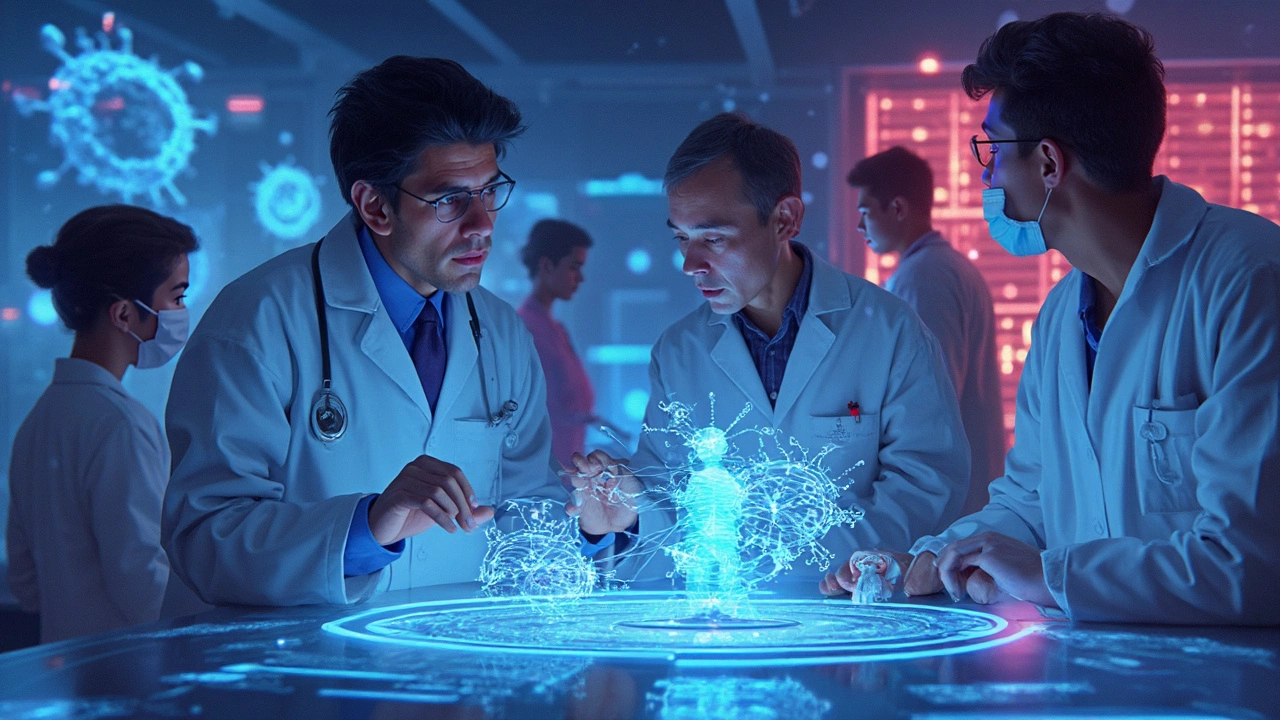
When we hear the word 'cancer,' it's easy to feel overwhelmed, especially given the sheer variety of cancers out there. But here's a surprising fact: about 90% of all cancers fall under one type—carcinomas. These troublemakers start in the epithelial cells, the kind that line the surfaces of our organs and skin.
So why are carcinomas so prevalent? Well, epithelial cells are constantly dividing and replacing themselves, making them somewhat prone to errors. With every division, there's a chance for mutations, which can eventually lead to cancer if the body's usual repair systems don’t catch it. They affect places like the lungs, breasts, and colon—areas we all have to keep an eye on, especially as we age.
- What Makes Carcinomas So Common?
- Types of Carcinomas
- Risk Factors and Prevention
- Latest Treatments and Therapies
- Living with and Managing Carcinomas
What Makes Carcinomas So Common?
You might be wondering, why are carcinomas so widespread compared to other types of cancer? Well, it all starts with those hardworking epithelial cells. These cells cover a lot of ground in our bodies. They're like the protective wrapper on our organs and skin, constantly exposed to environmental factors and daily wear and tear.
Because epithelial cells need to be replaced quite often, they divide rapidly. More divisions mean more opportunities for DNA replication errors, which can lead to mutations. Usually, our immune system can catch and fix these errors. But sometimes, a glitch slips through, and that’s when trouble starts.
Let's get specific: Lung, breast, and colon cancers are among the most common types of cancer, and they're all carcinomas. For instance, lung cells are exposed to everything you breathe, from oxygen to pollutants, increasing their risk of developing cancer. Similarly, breast cells are particularly sensitive to hormonal changes, which can also drive mutations.
To put it in perspective, here's a simple breakdown:
- Lung carcinoma: Linked to smoking and pollution.
- Breast carcinoma: Influenced by genetics and hormone levels.
- Colon carcinoma: Diet and lifestyle play major roles.
Genetics also play their part. Families with histories of certain cancers might carry genetic mutations that elevate their risk. But fear not, awareness and early detection can make a big difference.
Types of Carcinomas
Carcinomas certainly steal the spotlight when it comes to common cancers. But did you know there are several different types of them? Yep! Let's break down the major ones you should know about.
First up, there's squamous cell carcinoma. This type usually affects areas like the skin, lungs, and esophagus. It's called 'squamous' because it forms in the flat, squamous cells that make up the outermost layer of the skin and some internal organs.
Then, we have adenocarcinomas. These start in glandular cells, which produce fluids like mucus. You'll find adenocarcinomas most often in the breasts, colon, and prostate. In fact, the majority of breast and prostate cancers fall into this category.
There's also basal cell carcinoma, which is the most common but least dangerous skin cancer. It grows slowly and rarely spreads, so it's often caught early and treated effectively.
Finally, we have transitional cell carcinoma, usually found in the urinary system, like the bladder and ureters. It affects the transitional epithelium, which is a fancy way of saying cells that can stretch and change shape.
Check out this quick overview of the occurrences in different body parts:
| Type | Common Locations | Prevalence |
|---|---|---|
| Squamous Cell Carcinoma | Skin, Lungs, Esophagus | High |
| Adenocarcinoma | Breasts, Colon, Prostate | Very High |
| Basal Cell Carcinoma | Skin | Highest |
| Transitional Cell Carcinoma | Urinary System | Moderate |
Knowing the types of carcinomas is key to understanding their impact and the importance of early detection and tailored treatments. So, if you see changes or feel something's not right, it's always worth a chat with your doc.

Risk Factors and Prevention
Diving into the nitty-gritty of what puts us at risk for carcinomas isn’t fun, but trust me, it's important. There's a mix of unavoidable and totally manageable factors here.
First off, let's talk things we can't change, like age and genetics. The longer we live, the more chances those pesky cell mutations have to sneak by. Also, if your family has a history of certain cancers, your odds increase.
Now, onto lifestyle stuff, where we can make a real difference. Smoking, for instance, is a huge no-go. It's linked to many types of carcinomas, especially in the lungs. Here's what you can do to stack the odds in your favor:
- Stop smoking and avoid secondhand smoke. Even if it’s tough, the benefits are huge.
- Eat more fruits and veggies. Yeah, it’s the same old advice, but a healthy diet gives our cells the nutrients they need to function properly.
- Wear sunscreen. UV exposure is the main cause of skin cancer, a very common type of carcinoma, so protect that skin!
- Keep fit and maintain a healthy weight. Obesity can increase your risk of several cancers.
- Limit alcohol. Too much booze can lead to carcinomas in the liver and beyond.
Feeling proactive? Regular check-ups can catch cancer early when treatments work best. Talk to your doctor about screenings, especially if cancer runs in your family.
Here’s a snapshot of how things stack up in terms of lifestyle risks:
| Factor | Increased Risk |
|---|---|
| Smoking | High |
| Unhealthy Diet | Moderate |
| Obesity | Moderate |
Keep in mind, these tips aren’t just about avoiding carcinomas. They’re about living healthier, fuller lives. Prevention is way better than dealing with the consequences down the line, don’t you think?
Latest Treatments and Therapies
When it comes to tackling carcinomas, the medical world is making exciting strides. With a range of options, from traditional therapies to cutting-edge approaches, there's hope for everyone fighting this common cancer.
For starters, the classic duo—surgery and radiation—remains a mainstay. Surgery aims to remove the tumor, while radiation uses high-energy rays to kill cancer cells. Together, they often do a great job in getting rid of carcinomas, especially when caught early.
Then, there's chemotherapy, the well-known drug treatment that targets rapidly growing cancer cells. Yes, it can be tough on the body, but it's become more precise, thanks to better understanding of how different cancers behave.
Immunotherapy is the buzzword today. It uses the body's own immune system to fight cancer. This approach is becoming increasingly popular, especially for those with cancers not responding to traditional treatments. Drugs like pembrolizumab have shown remarkable results in specific types of carcinomas.
Here's something cool: researchers are exploring targeted therapy, which zeroes in on specific molecules involved in cancer cell growth. This means fewer side effects compared to traditional chemotherapy. Ever heard of monoclonal antibodies? They’re a part of this targeted therapy, designed to flag cancer cells so the immune system can knock them out.
- Gene therapy, an emerging field, shows promise by altering genes to stop cancer growth.
- Stem cell transplants may restore blood-forming stem cells in patients after intensive treatments.
- Photodynamic therapy uses light-activated drugs to destroy cancer cells.
Catch this—sometimes, a mix of treatments is the best bet. This is called combination therapy, and it often yields better results than using a single approach.
| Treatment | Effectiveness | Common Uses |
|---|---|---|
| Surgery | High | Localized carcinomas |
| Radiation | Medium-High | Breast, lung cancer |
| Immunotherapy | Varies | Advanced stages |
With technology evolving rapidly, the list of cancer treatments keeps growing, offering more hope each year. Talking to your doctor about these options and what suits your specific case is the best step forward.

Living with and Managing Carcinomas
Dealing with carcinomas is tough, no doubt about it. But with proper management, many folks continue to lead full and active lives. It’s all about finding the right balance and knowing the steps to take after a diagnosis.
First things first: lean on your healthcare team. They're there to guide you through every phase. Regular check-ups and screenings are essentials. They're not just routine; they catch any changes early, which is crucial for effective cancer treatment.
Staying active is another vital piece of the puzzle. It's tempting to skip exercise when you're feeling low, but regular physical activity can boost your energy and mood. Even simple activities like walking or yoga can make a huge difference. Remember, it’s about feeling better, not running marathons (unless that's your thing!).
Nutrition also plays a big role. Eating a balanced diet helps keep your body strong. Focus on getting lots of fruits, veggies, and lean proteins. It might help to see a nutritionist, someone who can create a plan tailored just for you.
Let's talk about mental health for a sec. Living with cancer can be overwhelming, and it's okay to feel like that. Whether you find solace in talk therapy, support groups, or just chatting with a friend, don't keep it bottled up. Sharing your experiences helps, and sometimes you need that extra listening ear.
Lastly, stay informed. The world of cancer treatment is always evolving, with new therapies and drugs coming up. Talk to your doctor about the latest options that might be available to you. Staying informed helps in making decisions that best suit your situation.
Many patients find comfort in routine, setting small goals and focusing on what's within their control. It's important to celebrate the small victories and seek out joy in everyday moments—it lightens the load and reminds you that you're more than your diagnosis.

Write a comment